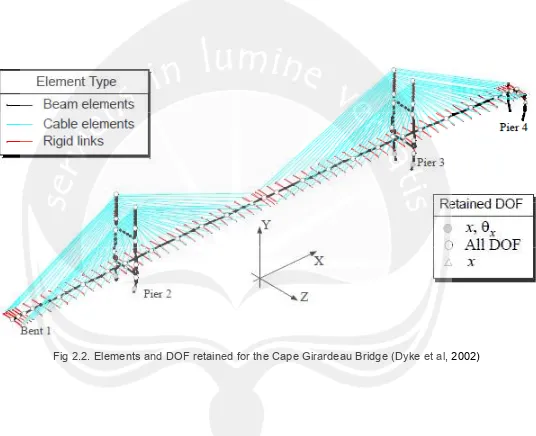CHAPTER 2
MODELLING THE BRIDGE
2.1. Finite Element Model of the Bridge
Based on the detailed information of the Cape Girardeau bridge, a
three-dimensional finite element model was developed in
MATLAB® (1997) by Dyke et al (2002). The evaluation model used
in this benchmark study is linear. However, the stiffness matrices
used in this linear model are those of the structure determined
through a nonlinear static analysis corresponding to the deformed
state of the bridge with dead loads (Wilson and Gravelle, 1991).
The nonlinear static analysis is performed using ABAQUS® (1998),
where the element mass and stiffness matrices are output to
MATLAB® for assembly.
The finite element model employs beam elements, cable
elements and rigid links. This model has a large number of degree
of freedom and high frequency dynamics. Some assumptions were
made regarding the behavior of the bridge while retaining the
fundamental behavior of the bridge. The constraints are applied to
the mass and stiffness matrices, and a reduction is performed to
reduce the size of the model to a more manageable model. The first
0.5158, 0.5812, 0.6490, 0.6687, 0.6970, 0.7102, and 0.7203 Hz.
These steps are summarized in Fig. 2.1.
This model is used as a basis of comparison for the controlled
system in which the deck-tower connections are fixed (the
dynamically stiff shock transmission devices are present).
Fig 2.1. Creating the Evaluation model (Dyke et al, 2002)
To make it possible for designers/researchers to place devices
acting longitudinally between the deck and the tower, a modified
evaluation model is formed in which the connections between the
tower and the deck are disconnected. If a designers/researcher
specifies devices at these nodes, the second model will be formed
as the evaluation model, and the control devices should connect
the deck to the tower. As one would expect, the frequencies of this
model are much lower than those of the nominal bridge model. The
first ten frequencies of this second model are 0.1618, 0.2666, ABAQUS
Nonlinear Static Analysis
Output, , Static Condensation
Assemble and Apply Constraint
Element and Apply Constraint
Modify FEM
0.3723, 0.4545, 0.5015, 0.5650, 0.6187, 0.6486, 0.6965, and
0.7094 Hz.
2.2. Reduced Model of the Bridge of Cape Girardeau
The reduction is done through static condensation technique. The
active DOFs retained in the model include (Dyke et al., 2002):
• the nodes at the top at each tower,
• the lowest nodes at which cables are connected on each tower,
• nodes at the joints of the tower,
• nodes or DOFs of elements whose shear and overturning
moment are among the design criteria,
• approximately every third mode of the bridge deck,
• rotational DOFs about the longitudinal and vertical axis of all
spinal decks nodes.
These locations are indicated in Fig 2.2. The result is a model with
419 degree of freedom.
Static condensation is performed by Dyke et al., by partitioning
the mass and stiffness matrices into active and dependent DOF as
in
where is the mass matrice, is the stiffness matrice, denote
the active DOF, and for the dependent DOF. Assuming that no
loads are applied to the dependent DOFs, the system equation for
static equilibrium is written as
(2-2)
where is the active, and is the dependent displacement vector.
Using the second row of eq.(2-2), the transformation matrix is
obtained as
(2-3)
where is the static transformation matrix, and is the identity
matrix of appropriate size, such that
(2-4)
The transformed mass and stiffness matrices are then as follows
and (2-5)
The corresponding coefficient matrices for the ground excitation
and the control forces are given by
Γ and Λ Λ (2-6)
Prior to making this transformation, Γ and Λ must be reordered
reduction scheme to the full model of the bridge resulted in a 419
DOF reduced order model. The first 100 natural frequencies of the
reduced model (up to 3.5 Hz) are in good agreement with those of
the 909 DOF structure. The damping in the system is defined based
on the assumption of modal damping. The damping matrix was
developed by assigning 3% of critical damping to each mode. This
value was selected to be consistent with assumptions made during
the design of the bridge. The reduced system was used to construct
the damping matrix using
Φ … (2-7)
where Φ is the modal matrix, and and are the natural
frequency [rad/sec] and modal damping ratio of the ith mode,
respectively. The resulting equation of motion for the damped
structural system is
Γ Λ (2-8)
where is the displacement vector of active DOFs. This model is
termed the evaluation model. It is considered to portray the actual
dynamics of the bridge and will be used to evaluate various control
Note that this model always includes the effects of the shock
transmission devices, which constraint longitudinal motion. The
evaluation model and earthquake inputs are fixed for this
